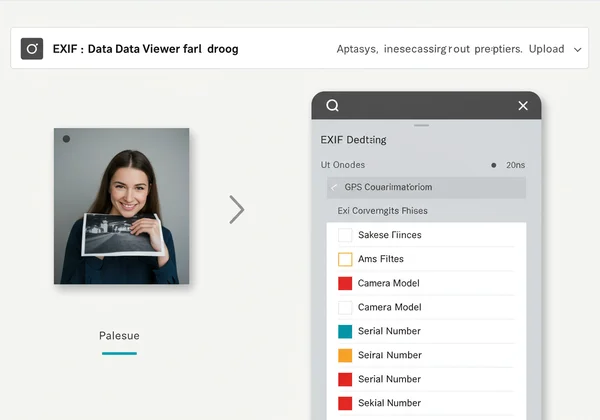Protect Photo Privacy: Advanced EXIF Data Removal Guide
You share your life through photos, but are you also sharing hidden personal details? Every time you post an image online, you could be exposing more than just a moment. Beyond GPS tags, your images often contain sensitive exif data that can compromise your privacy, from the exact device you used to unique serial numbers. This guide will reveal advanced privacy risks, show you how to find hidden metadata, and give you practical ways to remove it for safer sharing.
This isn't just about hiding where a photo was taken; it's about reclaiming control over your digital footprint. The first step to protection is awareness. Before you do anything else, you should see what information your photos are broadcasting to the world. You can check photo details safely and instantly on our homepage.
Unmasking Sensitive EXIF Data Fields Beyond GPS
While most people are aware of GPS data, a photo’s metadata contains a treasure trove of other potentially sensitive information. This hidden data, automatically embedded by cameras and smartphones, can paint a surprisingly detailed picture of your life, habits, and equipment. Understanding these fields is the first critical step toward robust photo privacy.

Location Data's Deeper Footprint: More Than Just Coordinates
Many users know to turn off location services, but EXIF location data can be far more revealing than a simple pin on a map. Advanced GPS modules embed not just latitude and longitude but also altitude, the direction the camera was facing, and even the speed of travel. For a privacy-conscious individual, this level of detail can reveal patterns of movement, daily routines, or the exact floor of an apartment building, providing a much deeper insight than simple coordinates. It's crucial to view image exif data to see the full scope of location information.
Your Digital Fingerprint: Camera Serial Numbers & Device Details
Every digital camera and smartphone has a unique serial number, and this identifier is often embedded directly into the EXIF data of every photo you take. This creates a digital fingerprint that can be used to link different photos—posted on various platforms under different usernames—back to a single device and, therefore, a single person. For journalists, activists, or even just private citizens, this can be a significant security risk. Knowing your photos contain this unique identifier is essential for anyone serious about their digital privacy.
Unwanted Exposure: Lens, Software, & Hidden Device Settings
Beyond unique identifiers, EXIF data reveals a host of technical details that can be used to build a profile about you. This includes the specific make and model of your lens, the version of the editing software you used (like Adobe Photoshop or Lightroom), and even custom device settings. While seemingly harmless, this information can reveal your level of photography expertise, your financial investment in equipment, and your software preferences. For professionals, it might even expose proprietary post-processing workflows.
Why Advanced EXIF Data Removal is Crucial for Photo Privacy
Understanding what sensitive data exists is only half the battle. The next step is recognizing why removing it is not just a technical task but a fundamental practice for modern digital safety. Effective exif data removal is about creating a protective barrier between your personal life and the public domain, benefiting everyone from casual social media users to professional content creators.

Protecting Your Identity and Preventing Location Tracking
The most immediate benefit of stripping metadata is personal security. By removing GPS coordinates and unique device identifiers, you make it significantly harder for malicious actors to track your movements, identify your home or workplace, or link your online activities across different platforms. This practice of metadata privacy is a proactive defense against stalking, doxxing, and other forms of online harassment, giving you peace of mind every time you share a photo.
Safeguarding Professional & Personal Information for All Users
For professionals, EXIF data management is a matter of business security. Photographers can use IPTC metadata fields to embed copyright information, but they also risk leaking client location details or proprietary camera settings. Similarly, a company might inadvertently share internal information through metadata in product photos. By using an online exif viewer to review images before publication, businesses and freelancers can ensure they only share what they intend to.
Building Trust: Sharing Your Visual Story with Confidence
Ultimately, you want to share your photos freely, without privacy worries. When you know for certain that your images are free of sensitive hidden data, you can post with confidence. This is especially true for parents sharing photos of their children, individuals posting from sensitive locations, or anyone who values their privacy. Taking control of your photo metadata empowers you to tell your visual story on your own terms, without sacrificing your personal security. You can check your photos securely before you share them with the world.
Practical Strategies for Identifying & Removing EXIF Data Effectively
Now that you understand the risks, it's time for action. Implementing a workflow to check and strip exif data is easier than you think. The key is to make it a consistent habit before you upload, send, or share any image. Here are practical and effective strategies you can use today.
Checking Your Photos: How to View Hidden Metadata Online Instantly
Before you can remove data, you must first see what’s there. The safest and most effective way to do this is with a tool that respects your privacy. Many online viewers require you to upload your images to their servers, creating a new privacy risk.
This is where our online EXIF data viewer stands out. Our free photo metadata viewer works entirely within your browser. You can drag and drop an image, and all the metadata is processed locally on your computer—your photo is never uploaded to our servers. This guarantees complete privacy and security, allowing you to see everything from camera settings to hidden serial numbers without exposing your files.

Simple Steps to Strip EXIF Data Before Sharing Photos
Once you've identified sensitive information using a secure tool, there are several ways to remove it:
- Windows: Right-click the photo file, go to
Properties>Details, and click "Remove Properties and Personal Information." You can then choose to create a copy with all possible properties removed. - macOS: Open the image in the Preview app. Go to
Tools>Show Inspector, and then click the(i)tab and theGPSsub-tab. You can click "Remove Location Info" here. For more extensive data, re-saving or exporting the file often strips some metadata. - Photo Editors: Programs like Adobe Photoshop and Lightroom have "Save for Web" or "Export" functions that include options to control how much metadata is included in the final file.
Social Media's Role: What Happens to Your Photo Metadata Online?
A common question is: does Facebook/Instagram/Discord remove exif data? The answer is generally yes, but with caveats. Most major social media platforms automatically strip most EXIF data from uploaded images to protect user privacy and reduce file sizes. However, you should not rely on them completely.
Policies can change, and not all data may be stripped perfectly every time. Furthermore, the original file with all its metadata might be stored on their servers, even if it's not displayed publicly. The most secure approach is to remove exif data yourself before uploading, ensuring you are in full control of your privacy.
Take Control: Safeguarding Your Digital Footprint with Smart EXIF Data Management
In our digital world, a picture is worth more than a thousand words—it can be a map of your life, a record of your habits, and a fingerprint of your devices. Protecting your photo privacy is no longer an optional step for the tech-savvy; it's an essential practice for everyone. By being mindful of the sensitive information hidden within your images, you can take meaningful steps to protect yourself.

The journey to better digital security starts with awareness. Make it a habit to check your photos for hidden metadata before you share them. With a secure, private tool like our online EXIF data viewer, you can instantly see what your images are revealing. Take control of your digital narrative today.
Frequently Asked Questions About EXIF Data & Photo Privacy
How can I remove EXIF data from my photos?
First, you need to see what data is present. Use a secure image metadata viewer that processes files locally in your browser. After identifying sensitive information, you can use built-in features in Windows or macOS, or the "Export" functions in photo editing software, which often include options to strip metadata upon saving a new copy.
Does EXIF data reveal my exact location?
Yes, if your camera or smartphone has location services enabled for the camera app, the EXIF data can contain precise GPS coordinates (latitude and longitude), altitude, and even the direction you were facing. This can pinpoint the exact location where the photo was taken, which is a major privacy concern for many users.
Do social media platforms automatically strip EXIF data?
Most major platforms like Instagram, Facebook, and X (formerly Twitter) do strip the majority of EXIF data from photos upon upload to protect user privacy. However, it's safer not to rely solely on their processes. For maximum security, it's best practice to check and remove data yourself before uploading to any platform.
Can screenshots contain sensitive EXIF information?
Generally, screenshots do not contain the same rich EXIF data as a photo from a digital camera. They typically lack GPS, camera settings, and serial numbers. However, they do contain some metadata, such as color profiles, resolution, and sometimes the device model, so it's still wise to be aware of what information they carry before sharing them.